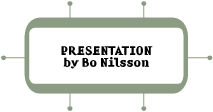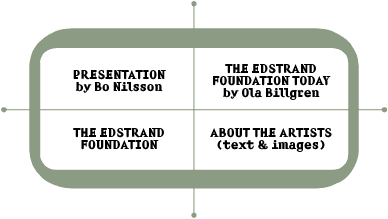
Foreword
The Edstrand Foundation is a nearly 50-year-old institution in the Scanian art world. A study of the foundation's history tells much about the changes in the art scene during the last decade. The foundation's support of art has evolved from an informal type of patronage, based of the personal art interests of the Edstrand siblings, to an economically powerful institution with an expressed grant policy. No longer may the prizes be characterized as alms to a poor profession but, rather, as prestigious rewards for distinguished artistic achievements. The changes in the nature of the prizes has placed the foundation into an authoritative position in the art community, where the grants play a role in affirming quality within an art scene run wild with no established system for evaluation.
The Edstrand Foundation has also shown a pliancy with regard to the geographic expansion of the art world. Moving beyond its roots in the local art scene, the foundation, in recent years, has extended the grant program to include artistic production throughout the Nordic region. This was a logical adaptation to the transnational art scene in the Nordic countries since the late 1980s. It is, however, increasingly difficult to speak of a national or Nordic art scene. Today, we find ourselves in the midst of a somewhat new situation, where integration with the international art community is already a reality, and many signs indicate that regional and global art communities will cooperate ever more in interlinked projects. Fitting with the foundation's receptivity to changes in art, in the future, selection of grant recipients will be done with an eye to regional, Nordic, and international art. This is a challenging concept, completely in line with Rooseum's exhibition policy.
Responsive to the art community's open-minded attitude toward artistic media, the Edstrand Foundation has chosen not to create any artificial limitations with regard to media in handing out the prizes. Today, where barriers are regularly being dismantled, and where media often overlap or hybridize, it is all the more difficult to refer to an artist as a painter, a sculptor, a photographer, or an installation artist. This observation is all the more evident upon viewing the prize winners of recent years. Instead of focusing on media, the choice of recipients has been based on the ability of each artist to handle his or her medium or media and the possibilities of expression related to the medium's properties.
From a past where samplings from the oeuvres of art grant winners were displayed mostly from a sense of duty, recent years have found awards regularly accompanied by exhibitions. In connection with this change, it may also be noted that award shows are increasingly being incorporated into the exhibition programs of various institutions. The Hugo Boss Prize, which is linked with the Guggenheim Museum in New York, serves as one example. But it is perhaps the Turner Prize, awarded by the Tate Gallery in London each year, which has garnered the most attention of late.
With this exhibition, a cooperation is being forged between Rooseum and the Edstrand Foundation. Rooseum has committed to produce shows for three years based on the work of the Edstrand Foundation Art Prize winners, which will be included in the museum's normal exhibition program. This means that the distribution of the prizes will change from being an internal affair for a small segment of the art community, to being an open event with an accessibility guaranteeing a greater participation from the art public.
This year's exhibition is not dominated by any artistic tendency or any medium. Rather, the show is distinguished by contemporary art's multifaceted use of media, which includes painting, sculpture, craft, photography, film, video, installation and performance or combinations of these media, where the distinctions between them reach a state of dissolution. Due to the diverse artistic tendencies and media represented here, we have chosen to put together a show which has the quality of nine separate exhibitions, in order that each artist may work with complete spatial integrity. Despite having no predominant theme, it should not be misconstrued that there are no affiliations between the works. It is, however, the individual artistry which is the focus of the exhibition rather than any thematic similarities. If one insists on seeking out points of unification within the exhibition, I think the artistic quality is a good starting point. This is the essential factor in evaluating contemporary Nordic art's new golden age, which is increasingly spoken of today.
I would like to thank all who have made this collaboration possible. This includes, of course, the Edstrand Foundation, which placed its trust in Rooseum as the exhibition site, and also the foundation's advisory board of Ola Billgren, Staffan Nihlén, and Sune Nordgren. The high standards they used in selecting the winners significantly contributed to an exciting exhibition. I would also like to direct a big word of thanks to the artists who, on short notice, took on the exhibition project with enormous energy. Last but not least, I want to thank Rooseum's personnel and, foremost, the curator of the exhibition, Magnus Jensner.
Bo Nilsson
Director
|




![]()